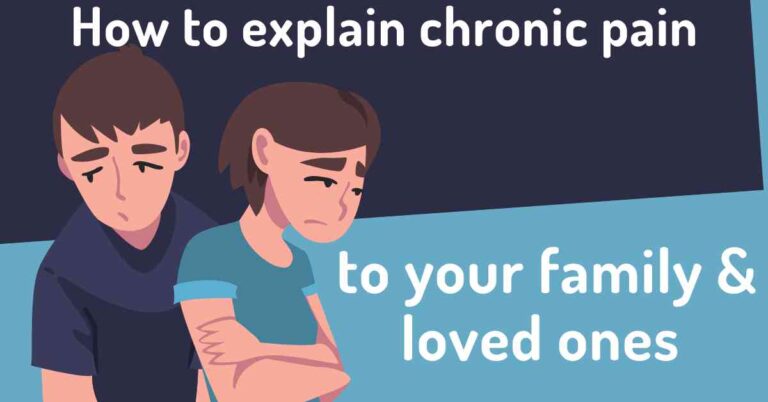Living with chronic pain can be a challenging and isolating experience. It can be challenging when your family members do not fully understand your condition. However, improving communication and understanding with your loved ones is possible. This article will discuss practical strategies to help you understand how to explain chronic pain to your family and loved ones.
No matter how much explaining is done, people without chronic pain can never fully understand it. With some effort, finding common ground and transforming it into better relationships between you and your loved ones is possible.
Why is it difficult for people without chronic pain to understand chronic pain?

People without chronic pain may find it challenging to understand it because pain is a subjective experience, and everyone experiences it differently. Chronic pain is also different from acute pain, which is the pain that typically results from an injury or illness and goes away once the underlying condition has healed. Chronic pain can also be unpredictable; what works one day to manage it may not work the next.
Additionally, people without chronic pain may have preconceived notions or stereotypes about how pain should be managed. They may not understand that pain management is not always as simple as taking medication and that living with chronic pain often requires a comprehensive, multifaceted approach that may involve physical therapy, lifestyle modifications, and psychological support.
How to communicate your chronic pain to your family:
- Educate your family. The first step to helping your family understand your chronic pain is to educate them about the condition. Chronic pain is defined as pain lasting more than three months and can result from various medical conditions, injuries, or illnesses. Explain your pain, causes, and potential treatment options to your family members.
- Communicate openly. It is crucial to have open communication with your family about your chronic pain. Explain how it feels, how it affects you, and what triggers the pain. Describe the limitations of the pain on your daily activities. Let your family know that chronic pain is an actual condition and that it can be debilitating, even if it is not always visible.
- Involve them in your treatment. Another way to help your family understand chronic pain is to involve them in your treatment plan. Explain what treatments you are undergoing and how they are helping. Invite them to attend medical appointments with you so they can hear directly from your healthcare provider about the condition and treatment. This can also allow them to ask questions and express their concerns.
- Be patient. It may take time for your family to understand your chronic pain fully, so it is essential to be patient with them. Remember that they may not fully comprehend the condition’s severity and may need time to adjust their expectations of you. Please encourage them to be supportive and understanding while you manage your pain.
- Be open and upfront about things your loved ones can do to help you feel better. Often, your loved ones do not know how they can help, and therefore can develop frustration of wanting to help but not understanding what they can do. Being clear about things they can do that help or make it worse is a significant step towards reducing any friction from not understanding your needs fully.
- Communicate your mood, especially if you are in a bad mood but are not irritated towards your loved ones. Frequently, a loved one may feel like you are upset with them when the real reason is the pain you are experiencing. Your loved ones try hard to support you, so communicate your appreciation to them and specify that your mood is related to your pain level and not anything they’ve done wrong.
Consider their viewpoint:
It’s essential to understand your chronic pain affects your loved ones directly, too! Try to understand from their viewpoint that many times after trying to be helpful, they may not feel like it was effective. Over time, this can build up and create stress for your loved ones. Try to put yourself in their shoes and empathize with their feelings. Encourage open and honest communication, and listen closely to their concerns.
Caring for a loved one with chronic pain can be a challenging and often exhausting experience. Here are some reasons why:
- Physical demands: Chronic pain can limit your ability to perform everyday activities, such as dressing, cooking, or cleaning. Your loved ones may need to provide physical assistance or do these tasks, which can be physically demanding and tiring.
- Emotional toll: Chronic pain can also significantly impact both the person experiencing it and their caregiver. Loved ones may feel frustrated or helpless when they see you in pain and unable to do the things you used to enjoy. It can also be emotionally draining to witness your struggle with the pain and its impact on your quality of life.
- Time commitment: Caring for a loved one with chronic pain can be a full-time job and may require significant time commitments. They may accompany you to medical appointments, help manage your medication, or provide round-the-clock support.
- Financial burden: Chronic pain can be expensive to manage, and your loved ones may need to help you navigate the healthcare system and manage medical bills. You may also need to take time off work to provide care, which can result in lost wages and financial strain.
- Limited resources: Caring for a loved one with chronic pain can be challenging and may require specialized knowledge and resources. Your family and loved ones may not have the necessary resources, such as healthcare providers or support groups, to help you manage your condition effectively.
Caring for a loved one with chronic pain can be a challenging and complex experience that requires significant physical, emotional, and financial resources. Additionally, these stressors can build up over time if an effective communication strategy is not implemented.
Get outside support

If you are experiencing chronic pain, several types of support are available to help you manage your condition effectively. Getting support from outside your internal network can help reduce the stress on your loved ones.
Some of these include:
- Healthcare providers: Your primary care physician or a specialist, such as a pain management doctor, can help diagnose and manage your chronic pain. They can provide treatments such as medications, physical therapy, or counseling to help you manage your pain.
- Support groups: Support groups are an excellent resource for people with chronic pain. They provide a safe and supportive environment where you can connect with others who understand what you are going through. Support groups may be in-person or online, and they can help you feel less alone in your experience.
- Psychological support: Chronic pain can significantly impact your mental health, and it is essential to seek psychological support if you need it. This may include counseling or therapy to help you manage the emotional impact of chronic pain.
- Lifestyle modifications: Lifestyle modifications such as exercise, stress management, and healthy eating can help manage chronic pain. These can include activities such as yoga, meditation, or acupuncture.
- Education: Education about your condition and pain management techniques can help you better understand and manage your pain more effectively. This may include classes or resources provided by your healthcare provider or online resources from reputable organizations such as the National Institutes of Health.
- Technology: There are several types of technology available to help manage chronic pain, such as wearable devices, mobile applications, or virtual reality therapy. These can provide alternative pain management strategies and help you better manage your pain.
Conclusion
In conclusion, living with chronic pain is challenging, but with the right strategies, you can help your family understand your condition. In the long term, building an effective communication strategy for both you and them is essential.
By educating them, communicating openly, involving them in your treatment, practicing empathy, and being patient, you can create a supportive environment that helps you manage your pain effectively. Remember, increasing understanding will take time and effort, but improving your family’s awareness and support is possible with persistence and patience.
Find more stories on the blog.
References:
- National Institute of Neurological Disorders and Stroke (NINDS) – Chronic Pain Information Page: https://www.ninds.nih.gov/Disorders/All-Disorders/Chronic-Pain-Information-Page This page provides a comprehensive overview of chronic pain, its causes, and potential treatment options.
- American Chronic Pain Association: https://www.theacpa.org/ This organization provides education, advocacy, and support for people with chronic pain.
- Pain Management and Treatment Center at the University of California San Francisco: https://www.ucsfhealth.org/clinics/pain_management_and_treatment_center/ This center provides a comprehensive approach to managing chronic pain, including medication management, physical therapy, and psychological support.
- National Center for Complementary and Integrative Health (NCCIH) – Chronic Pain: https://www.nccih.nih.gov/health/chronic-pain-in-depth This page provides information about complementary and integrative approaches to managing chronic pain, such as acupuncture and yoga.




